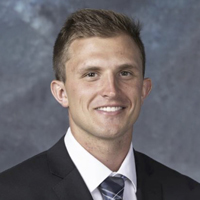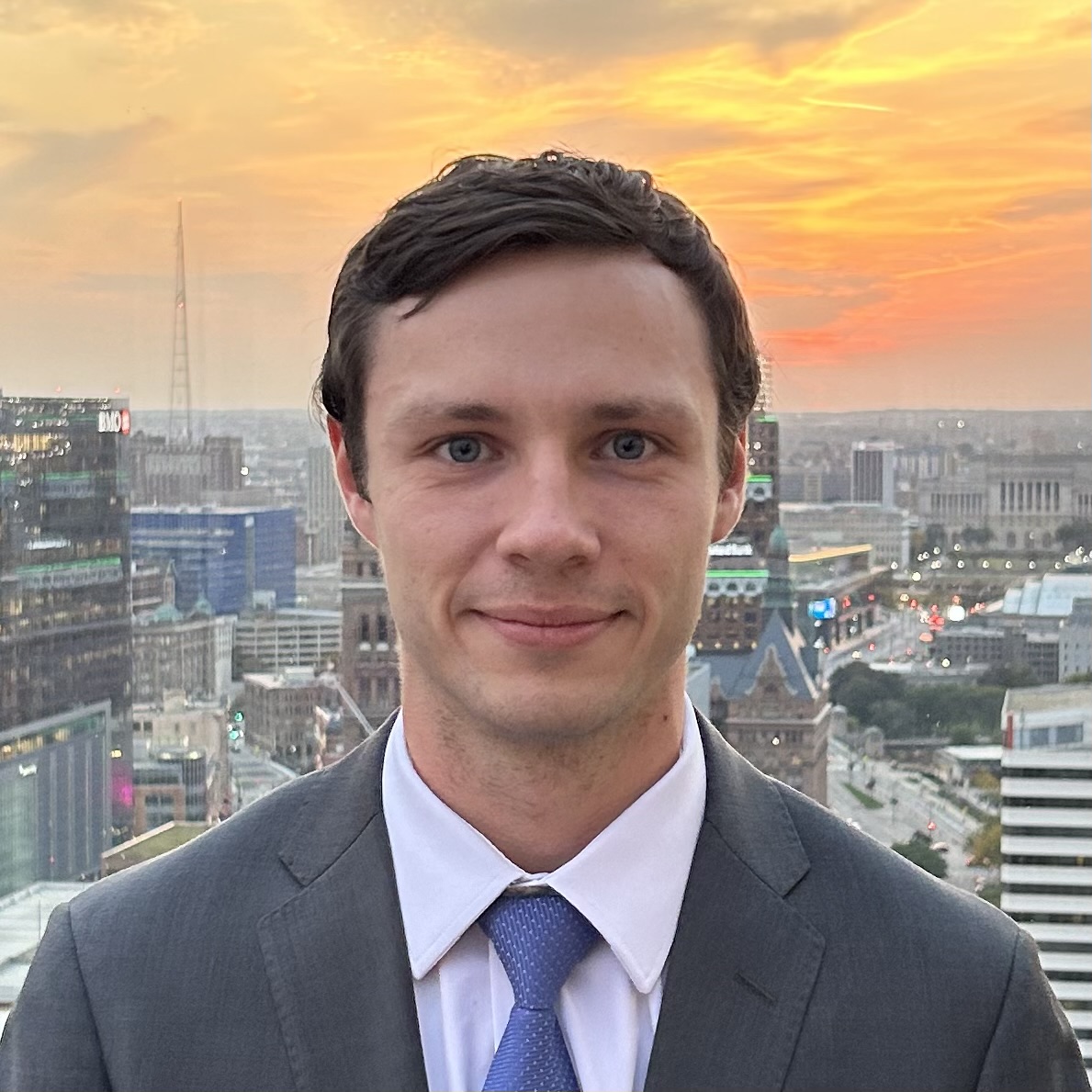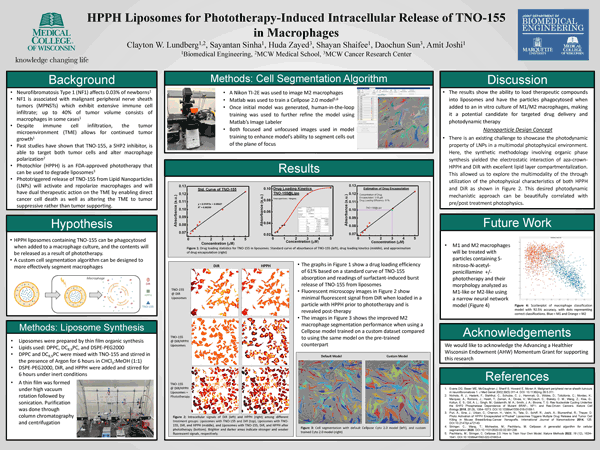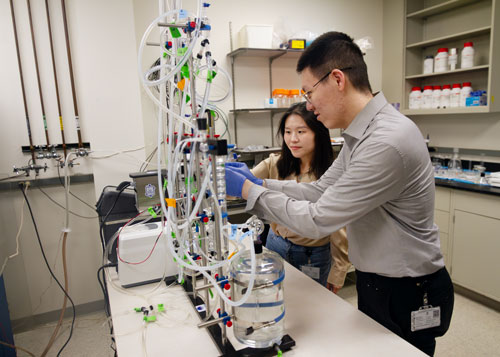Summer Medical Students Win Awards at CTSI Poster Session
November 4, 2024
At the conclusion of Summer, the Clinical and Translational Science Institute of MCW held a poster session on September 19th, where 163 medical students presented posters outlining their summer research programs, hosted by Summer Academic Programs for Medical Students (SAMS) and the Medical Student Summer Research Program (MSSRP). Out of the participating medical students presenting, 10 were awarded the 2024 Dr. Michael J. Dunn Poster Contest Award. Among the winners were Wesley Glime and Clayton Lundberg, medical students whose summer research experiences were hosted by the Marquette-MCW Joint Department of Biomedical Engineering.
Wesley Glime
Tissue Regenerative Engineering Laboratory
 Wesley Glime worked in Dr. Bo Wang’s Tissue Regenerative Engineering Laboratory (TRE Lab), which focuses on creating bio-functional engineered tissues to provide advanced treatments for conditions such as birth defects, bone disorders, and liver and vascular diseases. Wesley’s poster, titled “Fabrication of a Decellularized Human Amniotic Membrane Nanoparticle Coating for Small-Vessel ePTFE Grafts,” explored ways to improve synthetic blood vessel grafts. Cardiovascular disease (CVD), a leading cause of death in the U.S., often requires grafts to replace or bypass blood vessels. Using a patient’s own vessels isn’t always feasible, so synthetic materials like ePTFE (expanded polyfluoroethylene, a type of plastic) are employed. However, these materials tend to have a short lifespan, particularly in smaller vessels.
Wesley Glime worked in Dr. Bo Wang’s Tissue Regenerative Engineering Laboratory (TRE Lab), which focuses on creating bio-functional engineered tissues to provide advanced treatments for conditions such as birth defects, bone disorders, and liver and vascular diseases. Wesley’s poster, titled “Fabrication of a Decellularized Human Amniotic Membrane Nanoparticle Coating for Small-Vessel ePTFE Grafts,” explored ways to improve synthetic blood vessel grafts. Cardiovascular disease (CVD), a leading cause of death in the U.S., often requires grafts to replace or bypass blood vessels. Using a patient’s own vessels isn’t always feasible, so synthetic materials like ePTFE (expanded polyfluoroethylene, a type of plastic) are employed. However, these materials tend to have a short lifespan, particularly in smaller vessels.
The presented research focused on enhancing ePTFE by coating it with nanoparticles made from decellularized human amniotic membrane (DAM). This project expanded upon the results of prior research that displayed the ability of the DAM to improve reendothelialization and reduce thrombogenicity, or blood clotting. The hypothesis is that formation of a durable DAM nanoparticle coating would allow ePTFE grafts to perform better in small vessels.
 During their research, the TRE Lab tested three different types of polymers to identify which one would best assist with coating the ePTFE. Of the three, PLGA, or poly(D, L-lactide-co-glycolic acid), and PLCL, or poly(D, L-lactide-co-caprolactone), were the most promising in providing a durable nanoparticle coating as shown by fluorescence microscopy and SEM. Yet, further testing is needed to evaluate the mechanical properties and cellular compatibility through in vivo studies.
During their research, the TRE Lab tested three different types of polymers to identify which one would best assist with coating the ePTFE. Of the three, PLGA, or poly(D, L-lactide-co-glycolic acid), and PLCL, or poly(D, L-lactide-co-caprolactone), were the most promising in providing a durable nanoparticle coating as shown by fluorescence microscopy and SEM. Yet, further testing is needed to evaluate the mechanical properties and cellular compatibility through in vivo studies.
View Wesley's MSSRP Poster
LEARN MORE ABOUT TRE Lab
Clayton Lundberg
Nanomedicine & Image-Guided Interventions Laboratory
 Clayton Lundberg worked in Dr. Amit Joshi’s Nanomedicine & Image-Guided Interventions Laboratory (NIGIL), which focuses on developing minimally invasive and non-toxic diagnostic and therapeutic technologies targeting cancer, pulmonary and infectious diseases, and other vascular conditions. His poster, titled “HPPH Liposomes for Phototherapy-Induced Intracellular Release of TNO-155 in Macrophages,” concentrated on treating tumors in individuals with Neurofibromatosis Type 1 (NF1). NF1 is a genetic disorder that increases the risk of developing tumors called malignant peripheral nerve sheath tumors (MPNSTs), which often contain a high density of macrophages, a type of cell in the immune system. TNO-155 is a drug that can transform these macrophages from a type that eat particles and invading organisms like bacteria (M2) to a type that helps recruit other cells in the immune system to fight tumor cells (M1).
Clayton Lundberg worked in Dr. Amit Joshi’s Nanomedicine & Image-Guided Interventions Laboratory (NIGIL), which focuses on developing minimally invasive and non-toxic diagnostic and therapeutic technologies targeting cancer, pulmonary and infectious diseases, and other vascular conditions. His poster, titled “HPPH Liposomes for Phototherapy-Induced Intracellular Release of TNO-155 in Macrophages,” concentrated on treating tumors in individuals with Neurofibromatosis Type 1 (NF1). NF1 is a genetic disorder that increases the risk of developing tumors called malignant peripheral nerve sheath tumors (MPNSTs), which often contain a high density of macrophages, a type of cell in the immune system. TNO-155 is a drug that can transform these macrophages from a type that eat particles and invading organisms like bacteria (M2) to a type that helps recruit other cells in the immune system to fight tumor cells (M1).
In this study, the researchers proposed utilizing lipid-based nanoparticles (liposomes) encapsulating TNO-155 and the FDA-approved photosensitizer HPPH to achieve a dual-targeting mechanism: the HPPH ruptures the particles when exposed to light (phototherapy) and creates substances harmful to the tumor, known as reactive oxygen species, while the TNO-155 prevents tumor growth and promotes the conversion of local macrophages from their M2 to their M1 subtype. MPNSTs are known to contain large numbers of M2 macrophages, and liposomes can take advantage of their particle-eating capabilities to deliver drugs like TNO-155. The hypothesis is that liposomes containing TNO-155 will be taken up by macrophages and will release the drug within the cells when phototherapy is applied.
 To test this, the researchers created liposomes containing TNO-155 and used confocal fluorescent microscopy to observe absorption of the liposomes by macrophages and monitor drug release after phototherapy, which the experiments successfully demonstrated. These findings suggest that the liposome delivery system could alter the tumor microenvironment and improve treatment outcomes for MPNSTs. Future research will focus on examining how this treatment affects macrophage behavior and tumor growth in vivo, while also enhancing the liposome design for improved drug retention and controlled release.
To test this, the researchers created liposomes containing TNO-155 and used confocal fluorescent microscopy to observe absorption of the liposomes by macrophages and monitor drug release after phototherapy, which the experiments successfully demonstrated. These findings suggest that the liposome delivery system could alter the tumor microenvironment and improve treatment outcomes for MPNSTs. Future research will focus on examining how this treatment affects macrophage behavior and tumor growth in vivo, while also enhancing the liposome design for improved drug retention and controlled release.
View Clayton's MSSRP Poster
Learn more about NIGIL
About Summer Academic Programs for Medical Students
The Summer Academic Programs for Medical Students (SAMS) is hosted by the Clinical and Translational Science Institute or Southeast Wisconsin at the Medical College of Wisconsin Milwaukee campus and offers summer fellowships to MCW medical students wishing to participate in a rigorous research or academic experience during the summer between M1 and M2 years.
The Medical Student Summer Research Program (MSSRP) is the largest program within the SAMS. In the MSSRP, a limited number of students are selected to work in research labs alongside full-time MCW faculty members. These opportunities are designed to expose medical students to cutting-edge basic science, clinical or translational research and to encourage them to explore careers in research and academic medicine. The program is competitive, and chosen students work full-time during the summer.
Funding for the MSSRP comes from the National Institutes of Health (NIH) and other organizations.
Learn more about SAMS

 Wesley Glime worked in Dr. Bo Wang’s Tissue Regenerative Engineering Laboratory (TRE Lab), which focuses on creating bio-functional engineered tissues to provide advanced treatments for conditions such as birth defects, bone disorders, and liver and vascular diseases. Wesley’s poster, titled “Fabrication of a Decellularized Human Amniotic Membrane Nanoparticle Coating for Small-Vessel ePTFE Grafts,” explored ways to improve synthetic blood vessel grafts. Cardiovascular disease (CVD), a leading cause of death in the U.S., often requires grafts to replace or bypass blood vessels. Using a patient’s own vessels isn’t always feasible, so synthetic materials like ePTFE (expanded polyfluoroethylene, a type of plastic) are employed. However, these materials tend to have a short lifespan, particularly in smaller vessels.
Wesley Glime worked in Dr. Bo Wang’s Tissue Regenerative Engineering Laboratory (TRE Lab), which focuses on creating bio-functional engineered tissues to provide advanced treatments for conditions such as birth defects, bone disorders, and liver and vascular diseases. Wesley’s poster, titled “Fabrication of a Decellularized Human Amniotic Membrane Nanoparticle Coating for Small-Vessel ePTFE Grafts,” explored ways to improve synthetic blood vessel grafts. Cardiovascular disease (CVD), a leading cause of death in the U.S., often requires grafts to replace or bypass blood vessels. Using a patient’s own vessels isn’t always feasible, so synthetic materials like ePTFE (expanded polyfluoroethylene, a type of plastic) are employed. However, these materials tend to have a short lifespan, particularly in smaller vessels.
 Clayton Lundberg worked in Dr. Amit Joshi’s Nanomedicine & Image-Guided Interventions Laboratory (NIGIL), which focuses on developing minimally invasive and non-toxic diagnostic and therapeutic technologies targeting cancer, pulmonary and infectious diseases, and other vascular conditions. His poster, titled “HPPH Liposomes for Phototherapy-Induced Intracellular Release of TNO-155 in Macrophages,” concentrated on treating tumors in individuals with Neurofibromatosis Type 1 (NF1). NF1 is a genetic disorder that increases the risk of developing tumors called malignant peripheral nerve sheath tumors (MPNSTs), which often contain a high density of macrophages, a type of cell in the immune system. TNO-155 is a drug that can transform these macrophages from a type that eat particles and invading organisms like bacteria (M2) to a type that helps recruit other cells in the immune system to fight tumor cells (M1).
Clayton Lundberg worked in Dr. Amit Joshi’s Nanomedicine & Image-Guided Interventions Laboratory (NIGIL), which focuses on developing minimally invasive and non-toxic diagnostic and therapeutic technologies targeting cancer, pulmonary and infectious diseases, and other vascular conditions. His poster, titled “HPPH Liposomes for Phototherapy-Induced Intracellular Release of TNO-155 in Macrophages,” concentrated on treating tumors in individuals with Neurofibromatosis Type 1 (NF1). NF1 is a genetic disorder that increases the risk of developing tumors called malignant peripheral nerve sheath tumors (MPNSTs), which often contain a high density of macrophages, a type of cell in the immune system. TNO-155 is a drug that can transform these macrophages from a type that eat particles and invading organisms like bacteria (M2) to a type that helps recruit other cells in the immune system to fight tumor cells (M1).

